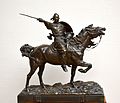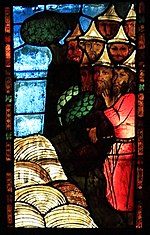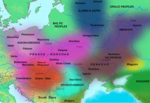Saltovo-Mayaki or Saltovo-Majaki is the name given by archaeologists to the early medieval culture of the Pontic steppe region roughly between the Don...
4 KB (383 words) - 04:09, 20 August 2024
Khazars (category Saltovo-Mayaki culture)
Sarkel. A number of Khazar settlements have been discovered in the Mayaki-Saltovo region. Some scholars suppose that the Khazar settlement of Sambat on...
218 KB (25,567 words) - 00:36, 26 December 2024
Bulgars (category Saltovo-Mayaki culture)
the north of the town Karachayevsk, where the pottery belonged to the Saltovo-Mayaki culture. Kuznecov also found a connection in the plan of the Danube...
99 KB (11,305 words) - 14:38, 12 December 2024
that can refer to: Golden Hills, California Golden Hills (Russia), a Saltovo-Mayaki archaeological site in southern Russia, near Rostov This disambiguation...
201 bytes (58 words) - 15:29, 28 December 2019
haplogroup has been identified in Alan burials associated with the Saltovo-Mayaki culture. In a 2014 study by V. V. Ilyinsky on bone fragments from ten...
46 KB (3,796 words) - 00:46, 20 December 2024
Hungarian prehistory (category Saltovo-Mayaki culture)
finds show that the Khagans controlled a multi-ethnic empire. The "Saltovo-Mayaki culture", which flourished in the same region around 750 and 900, had...
90 KB (11,101 words) - 23:15, 3 December 2024
Alans (category Saltovo-Mayaki culture)
Archaeology in Moscow conducted research on various Sarmato-Alan and Saltovo-Mayaki culture Kurgan burials. In this analysis, the two Alan samples from...
63 KB (6,709 words) - 20:36, 5 December 2024
Sviatoslav's campaigns led to increased Slavic settlement in the region of the Saltovo-Mayaki culture, greatly changing the demographics and culture of the transitional...
42 KB (4,970 words) - 11:26, 23 November 2024
again Afanasiev et al. analyzed skeletons of various Sarmato-Alan and Saltovo-Mayaki culture Kurgan burials. The two Alan samples from the fourth to sixth...
81 KB (8,707 words) - 18:42, 27 December 2024
as early as 30,000 BC indicates the Saltovo-Mayaki were Antratsyt's earliest ancestors. Since the Saltovo-Mayaki were nomadic, the area was left uninhabited...
14 KB (1,279 words) - 23:27, 2 December 2024
Sarkel (category Saltovo-Mayaki culture)
Sarkel (or Šarkel, literally "white house" in the Khazar language) was a large limestone-and-brick fortress in what is now Rostov Oblast of Russia, on...
9 KB (985 words) - 20:13, 18 July 2024
Pontic–Caspian steppe). Moshchevaja Balka is considered part of the Saltovo-Mayaki archaeological culture. The caftan is associated with a pair of silk...
10 KB (1,275 words) - 04:18, 24 October 2023
Atil (category Saltovo-Mayaki culture)
Atil, also Itil, was the capital of the Khazar Khaganate from the mid-8th century to the late 10th century. It is known historically to have been situated...
12 KB (1,384 words) - 06:34, 27 December 2024
longer period. In the same area, three or four local variants of the Saltovo-Mayaki archaeological culture, which represented semi-nomadic groups, emerged...
27 KB (3,317 words) - 10:36, 3 November 2024
In particular older stirrups are analogous to 8th-9th centuries C.E. Saltovo-Mayaki culture stirrups, while other stirrups are comparable to those utilized...
43 KB (4,129 words) - 20:18, 26 December 2024
Sviatoslav's campaigns led to increased Slavic settlement in the region of the Saltovo-Mayaki culture, greatly changing the demographics and culture of the transitional...
29 KB (3,273 words) - 19:47, 21 December 2024
Severians (category Saltovo-Mayaki culture)
in forests or on elevations, around which villages developed. Some Saltovo-Mayaki forts were situated on Severian land. In the Primary Chronicle, it is...
13 KB (1,313 words) - 17:50, 26 December 2024
Golden Hills Kaffa Kavkaz Kazarki Kerch Kerem Khazaran Khumar Levedia Saltovo-Mayaki Samandar Sambalut Sambat Samiran Samosdelka Saqsin Sarkel Semikarakorsk...
4 KB (470 words) - 06:27, 17 December 2024
and 10th centuries, it was a site of a fortified Khazar settlement of Saltovo-Mayaki culture. In the 18th and 19th centuries, the area attracted hermits...
74 KB (1,964 words) - 21:20, 17 December 2024
and Svetlana Pletnyova consider the eighth-century emergence of the Saltovo-Mayaki culture in the steppe region between the Don and Dnieper Rivers as resulting...
83 KB (11,674 words) - 13:46, 23 December 2024
Semikarakorsk Fortress (category Saltovo-Mayaki culture)
Semikarakorsk Fortress (Russian: Семикаракорская крепость) was an early medieval Khazar fortification situated near the city of Semikarakorsk (Rostov Oblast...
4 KB (406 words) - 05:09, 29 October 2024
Kushnarenkovo culture) from Cis-Ural and Trans-Ural region, and multiethnic "Saltovo-Mayaki culture" of the Pontic steppes. Most cemeteries from the 9th and 10th centuries...
113 KB (14,062 words) - 07:09, 17 December 2024
Proto-Indo-Europeans Krivoye Lake – Proto-Aryans Ladoga – Vikings/Rus' Mayatskoye – Saltovo-Mayaki culture Maykop – Proto-Indo-Europeans Pazyryk – Scythians Phanagoria...
73 KB (6,075 words) - 03:00, 5 December 2024
Haplogroup G-FGC7535 (category Saltovo-Mayaki culture)
Haplogroup G-FGC7535, also known as Haplogroup G2a1 (and formerly G-L293), is a Y-chromosome haplogroup. It is an immediate descendant of G2a (G-P15),...
13 KB (1,475 words) - 18:45, 7 December 2024
style wheel-made pottery (called Pastyrske or Saltovo ware), most commonly found within the Saltovo-Mayaki culture, associated with Bulgars, Khazars and...
13 KB (1,696 words) - 02:48, 26 November 2024
Verkhnii Saltiv (museum-reserve) (category Saltovo-Mayaki culture)
Kharkiv Oblast, Ukraine. The reserve covers one of the type sites of the Saltovo-Mayaki culture, the main archaeological culture of the Khazars, with the other...
6 KB (678 words) - 07:09, 28 June 2024
culture Hongshan culture Čaatas culture Askiz culture Kurumchi culture Saltovo-Mayaki Saymaluu-Tash Bilär Por-Bazhyn Ordu-Baliq Jankent There are several...
199 KB (21,459 words) - 15:18, 24 December 2024
Timișoara around 900. Cauldrons and further featuring items of the "Saltovo-Mayaki culture" of the Pontic steppes were unearthed in Alba Iulia, Cenad,...
194 KB (24,005 words) - 12:01, 2 November 2024
animal style dates back to Scythian art, having been prominent in the Saltovo-Mayaki culture. Schapov explains this by the fact that Vsevolod the Big Nest...
10 KB (861 words) - 16:07, 28 November 2024
have noted the presence of a significant amount of artifacts of the Saltovo-Mayaki culture, associated with the Khazar Khaganate. The main marker of Volyntsevo...
7 KB (896 words) - 01:54, 26 November 2024




















